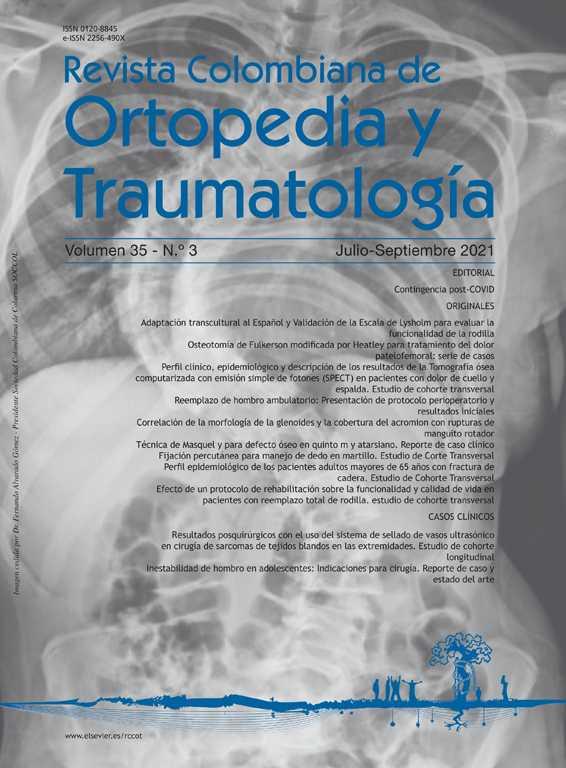Masquelet technique for fifth metatarsal bone defect. Case report
DOI:
https://doi.org/10.1016/j.rccot.2021.07.003Keywords:
Masquelet, Bone defect, Metatarsal, FootAbstract
Background: The Masquelet technique is used in the treatment of bone defects in long bones with high success rete reports. It has been described for the treatment of bone loss in the 1st metatarsal and midfoot. The aim of the report is to describe the experience with the technique in a patient with a bone defect of the fourth and fifth metatarsals associated with a transfixing skin defect.
Case report: In a 42-year-old patient who presented a gunshot wound to the lateral column of the right foot with subsequent transfixing coverage defect and bone defect due to comminuted fracture of the fourth and fifth metatarsals. Surgical treatment was performed in 3 stages, the first stabilization and surgical lavage, 2nd stage coverage with a reverse flow sural flap, fixation with a plate and a cement spacer. For a third stage, the bone cement was removed and an autologous cortico-cancellous bone graft was placed. Clinical and radiological follow-up was carried out for 18 months.
Results: The patient did not present complications including infection, presented anesthesia area in the sural nerve territory, complete viability of the flaps. Normal gait without metatarsalgia was evidenced and in the radiological evaluation it presents graft integration of 90% at described follow up term. Adequate space over the metatarsal cuboid interposition arthroplasty was observed, with a VAS of 1/10 and an AOFAS mid foot score OF 85.
Discussion: There are 7 reports in the literature about the Masquelet technique in the foot, with favorable results, mostly with functional restoration in complex cases in the medial column and no reports on the lateral column. In our case, the technique proves to be a viable alternative, achieving functional and structural restitution of the foot.
Evidence level: IV.
Downloads
References
Pelissier P, Bollecker V, Martin D, Baudet J. foot reconstruction whit de bi-masquelet procedure. Annales de Chirurgie Plastique Esthétique. 2002;48:304-7.
Karger C, Kishi T, Schneider L, Fitoussi F, Masquelet AC. Treatment of Posttraumatic bone defects by the induced membrane technique. Orthopaedics & Traumatology: Surgery & Research. 2012;98:97-102.
Feng L, Ruo-kun H, Ming X, Hao P, Jing-jing Z, Bo L. Use of Masquelet’s technique for treating the first metatarsophalangeal joint in cases of gout combined with a massive bone defect. Foot Ankle Surg. 2018;24:159-63, http://dx.doi.org/10.1016/j.fas.2017.01.009.
Giannoudis P, Harwood P, Tosounidis T, Kanakaris N. Restoration of long bone defects treated with the induced membrane technique: protocol and outcomes. Injury, Int. J. Care Injured. 2016;47S6:S53-61.
Huffman L, Harris J, Suk M. Using the Bi-Masquelet Technique and Reamer-Irrigator- Aspirator for Post-Traumatic Foot Reconstruction. Foot Ankle Int. 2009;30:895.
Largey A, Faline W, Hebrard M, Hamoui F, Canovas F. Management of massive traumatic compound defects of the foot. Orthopaedics & Traumatology: Surgery & Research. 2009;95:301-4.
Rincón-Cardozo DF, Camacho-Casas JA, Reyes-Núñez VA. Luxación y necrosis de la primera, segunda y tercera cuña, manejo con técnica de Masquelet Reporte de un caso. Acta Ortopédica Mexicana. 2013;27. Ene. -Feb: 55-59.
Mak MF, Stern R, Assal M. Masquelet Technique for Midfoot Reconstruction Following Osteomyelitis in Charcot Diabetic Neuropathy a Case Report. JBJS Case Connect. 2015;5:e28.
Makridis K, Theocharakis S, Fragkakis EM, Giannoudis PV. Reconstruction of an extensive soft tissue and bone defect of the first metatarsal with the use of Masquelet technique: A case report. Foot Ankle Surg. 2013;20:e19-22.
Morelli I, Drago L, George D, Gallazzi E, Scarponi S, Romanò CL. Masquelet technique: myth or reality? A systematic review and meta-analysis. Injury, Int. J. Care Injured. 2016;47(S6):S68-76.





